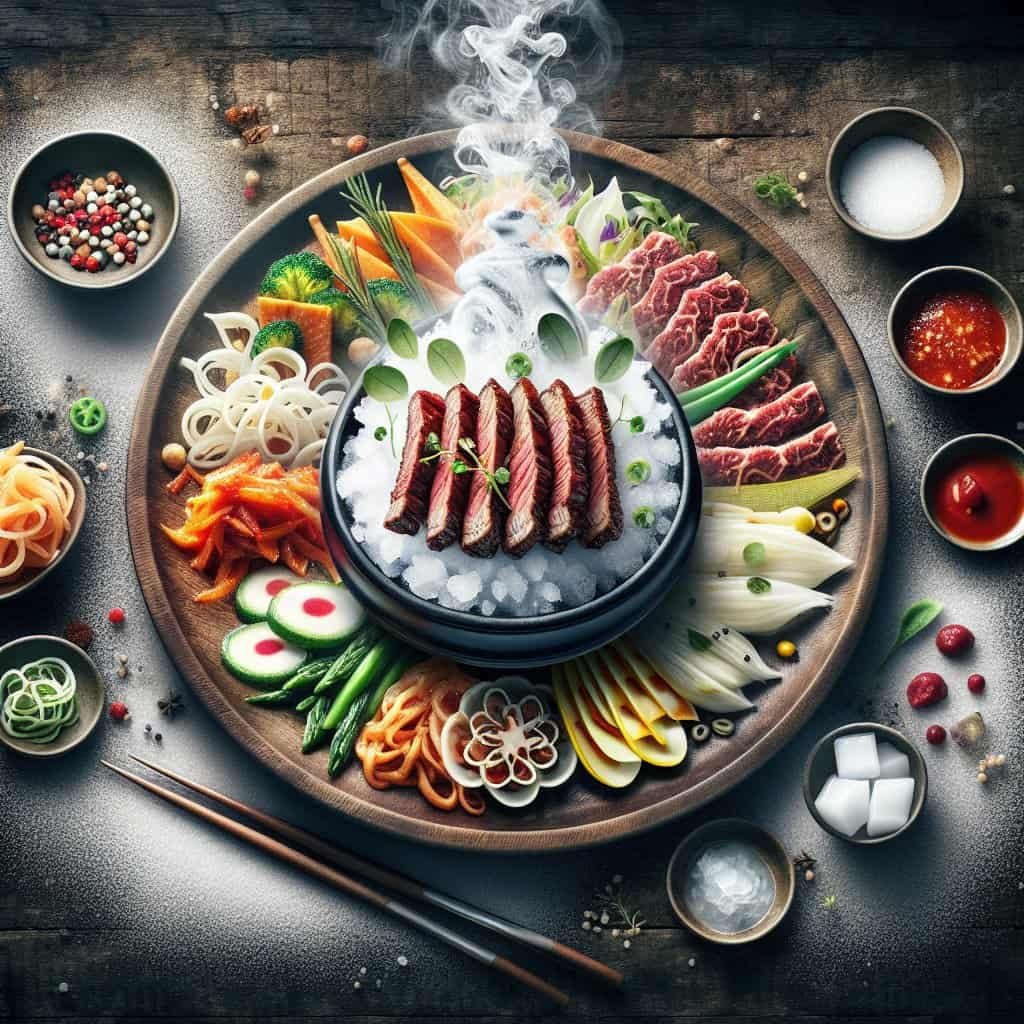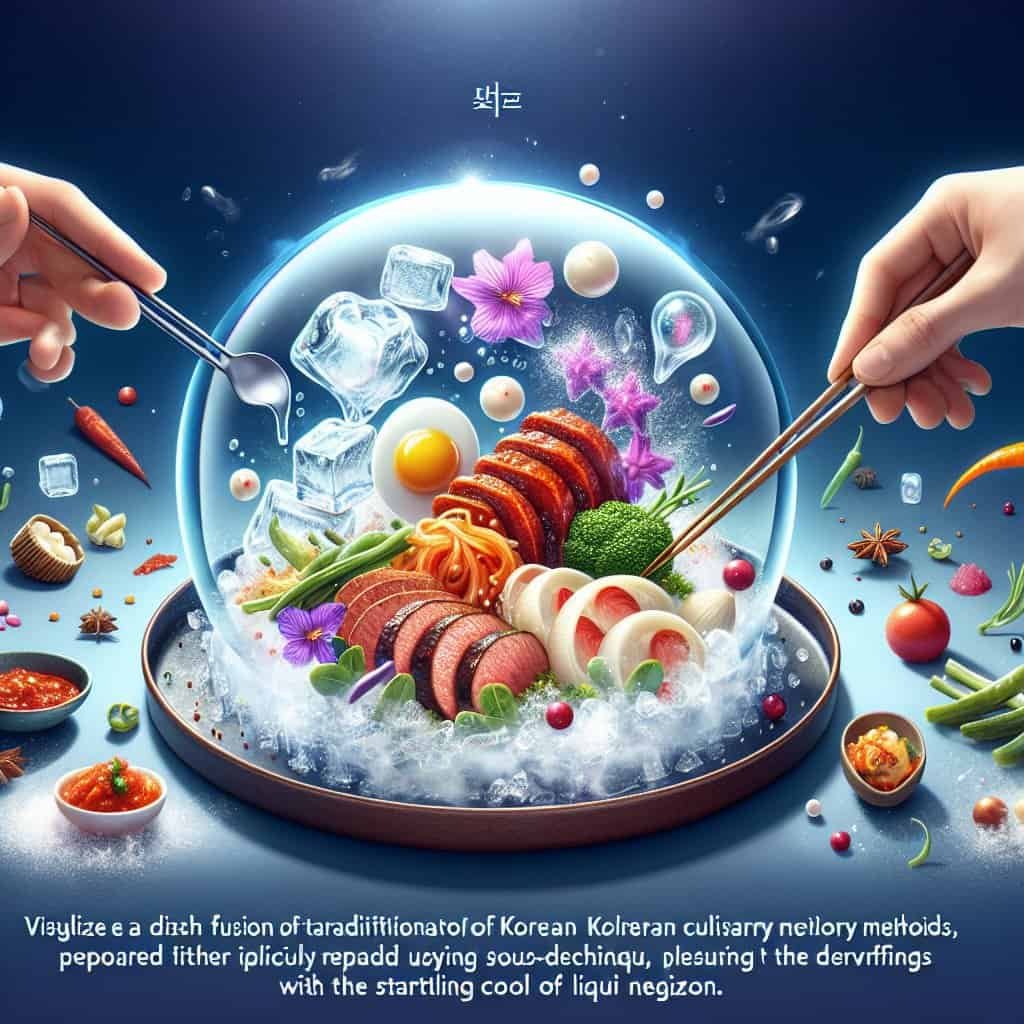In a world where culinary traditions continually evolve, today’s chefs are embracing the challenge of infusing modern techniques into traditional Korean recipes. By utilizing innovative cooking methods and fusion ingredients, these culinarians are finding ways to re-imagine classic dishes while staying true to the essence of Korean cuisine. From sous vide marinated bulgogi to nitrogen-infused kimchi, this article explores the fascinating ways chefs are breathing new life into time-honored recipes, creating a harmonious blend of old and new flavors that are sure to tantalize your taste buds.
Korean Cuisine: A Blend of Tradition and Modernity
Korean cuisine is a fascinating blend of tradition and modernity, with deep roots in the country’s history and a willingness to embrace innovative cooking techniques. The evolution of Korean cuisine has been driven by a desire to preserve authentic flavors while also adapting to the changing culinary landscape. In this article, we will explore how chefs have incorporated modern techniques into traditional Korean recipes, resulting in exciting new flavors and dining experiences.
The Evolution of Korean Cuisine
Korean cuisine has evolved over thousands of years, shaped by factors such as geography, climate, and cultural influences. Traditional Korean dishes are known for their bold flavors, vibrant colors, and diverse ingredients. However, as the world has become more interconnected, Korean chefs have been inspired by global culinary trends and techniques, leading to the incorporation of modern elements into their traditional recipes.
Modern Techniques in Traditional Korean Recipes
In recent years, Korean chefs have embraced modern cooking techniques to elevate traditional dishes to new heights. By combining age-old recipes with innovative methods, chefs have been able to create unique flavor profiles and enhance the overall dining experience.
Innovative Methods of Food Preparation
One way chefs are incorporating modern techniques into traditional Korean recipes is through innovative methods of food preparation. For example, traditional methods of fermenting ingredients have been maintained, but chefs have also introduced techniques such as sous vide cooking to ensure precise cooking temperatures and retain the natural flavors of the ingredients.

Use of Molecular Gastronomy in Korean Dishes
Molecular gastronomy, a scientific approach to cooking that focuses on the physical and chemical processes of food, has also found its way into Korean cuisine. Chefs are experimenting with techniques such as spherification, foam creation, and culinary foams to add a modern twist to traditional Korean dishes. These techniques not only enhance the visual appeal of the dishes but also provide unique flavor combinations and textures.
Fusion of Flavors: Traditional Korean Ingredients Meet Modern Culinary Trends
One of the most exciting aspects of modern Korean cuisine is the fusion of traditional Korean ingredients with international culinary trends. Chefs are incorporating locally sourced ingredients into classic Korean dishes, creating a harmonious blend of flavors. For example, traditional kimchi, a fermented vegetable side dish, is now being paired with ingredients like avocado or shrimp to add a contemporary touch to this staple dish.
Experimentation with International Ingredients
Korean chefs are also experimenting with international ingredients to bring a global twist to traditional recipes. By incorporating ingredients such as quinoa, kale, or even truffles, chefs are creating fusion dishes that appeal to both local and international palates. These innovative combinations not only elevate the flavors but also showcase the versatility and adaptability of Korean cuisine.

Modern Presentation: Elevating Traditional Korean Dishes
In addition to incorporating modern flavors and techniques, chefs are also focusing on the presentation of traditional Korean dishes. Artistic plating and garnishes play a crucial role in elevating the dining experience, making even the most classic dishes visually appealing.
Use of Modern Serveware and Tableware
To complement the modern presentation, chefs are also utilizing modern serveware and tableware. Traditional dishes are now served in sleek, minimalist plates or bowls, adding a contemporary touch to the dining experience. This attention to detail in both presentation and serveware reflects the commitment to blending tradition with modernity.
Healthier Variations: Balancing Tradition and Nutrition
As the world becomes more health-conscious, Korean chefs are finding ways to balance tradition with nutrition in their recipes. One of the ways this is achieved is by reducing the sodium and sugar content in traditional dishes while still preserving their authentic flavors.

Reducing Sodium and Sugar Content
Traditionally, Korean cuisine heavily relies on fermented and soy-based sauces, which can be high in sodium. However, chefs are now finding innovative ways to reduce the sodium content without compromising on taste. They are also using natural sweeteners or reducing the amount of sugar used in various dishes to create healthier variations.
Incorporating Superfoods into Traditional Korean Recipes
Another approach to creating healthier variations of traditional Korean recipes is by incorporating superfoods into the dishes. Superfoods like quinoa, chia seeds, and kale are rich in nutrients and antioxidants, making them a valuable addition to any diet. By integrating these ingredients into traditional Korean recipes, chefs are enhancing both the nutritional value and the complexity of flavors.
Importance of Preservation: Revitalizing Fermentation Techniques
Fermentation has long been a cornerstone of Korean cuisine, and chefs are embracing the importance of preserving traditional fermentation techniques. They are not only reviving age-old methods but also exploring new ways of incorporating fermented ingredients into their dishes.

Reviving Traditional Fermentation Methods
To preserve the authenticity of traditional Korean cuisine, chefs have taken the initiative to revive traditional fermentation methods. This involves meticulously following age-old techniques of fermenting ingredients like kimchi, soybean paste, and gochujang (a spicy fermented bean paste).
Exploring Fermented Ingredients in New Ways
In addition to reviving traditional fermentation methods, chefs are also exploring new ways to utilize fermented ingredients in their recipes. Fermented sauces are being used as bases for dressings, marinades, or even glazes. The complexity of flavors that fermentation brings adds depth and richness to the dishes, creating a unique culinary experience for diners.
The Role of Technology: From Smart Kitchens to Food Innovation
Technology has played a significant role in the modernization of Korean cuisine. Chefs are leveraging technological advancements to achieve precision cooking and explore new avenues for food innovation.

Leveraging Technology for Precision Cooking
With the advent of smart kitchens and advanced cooking equipment, chefs have access to precise temperature control and cooking methods. This level of precision allows them to maintain the integrity of ingredients while ensuring optimal cooking results. Whether it’s using sous vide machines for perfectly cooked meats or induction cooktops for controlled heat distribution, technology has become an indispensable tool in the modern kitchen.
Food Innovation with Sous Vide and Air-fryers
Chefs are also embracing food innovation through the use of sous vide and air-fryers. Sous vide cooking involves vacuum-sealing ingredients in a bag and cooking them at precise temperatures for extended periods. This technique results in tender, flavor-filled dishes that retain their natural juices. Air-fryers, on the other hand, allow chefs to achieve crispy textures without the need for excess oil. These innovative cooking methods are revolutionizing the way traditional Korean recipes are prepared and enjoyed.
Culinary Education: Passing on the Heritage Through Training Programs
To ensure the preservation of Korean culinary heritage, culinary education has taken center stage. Modern culinary schools are offering courses specifically focused on teaching traditional Korean cuisine, passing on the knowledge and techniques to the next generation of chefs.
Modern Culinary Schools Teaching Traditional Korean Cuisine
Culinary schools in Korea and around the world are recognizing the importance of teaching traditional Korean cuisine. These schools offer specialized programs that delve into the history, techniques, and flavors of Korean dishes. Through hands-on training, aspiring chefs learn the intricacies of Korean cuisine and are equipped with the skills to create their own modern interpretations.
Promoting Korean Culinary Techniques in Professional Trainings
Beyond culinary schools, professional training programs are also promoting Korean culinary techniques. Chefs from Korea are being invited to share their expertise in international kitchens, introducing chefs from different cultures to the intricacies of Korean cuisine. This exchange of knowledge and skills ensures that Korean culinary techniques continue to evolve and thrive in a global context.
Restaurant Revolution: Modernizing Korean Dining Experience
Restaurants play a crucial role in modernizing the Korean dining experience, showcasing traditional dishes with contemporary flair and creating innovative concepts to attract diners.
Dining Innovations and Conceptual Restaurants
Conceptual restaurants are at the forefront of the restaurant revolution in Korean cuisine. These establishments focus on creating unique dining experiences, often fusing traditional Korean recipes with modern culinary techniques. From interactive dining concepts to themed restaurants, they offer diners a chance to explore Korean cuisine in exciting and imaginative ways.
Korean Chefs Preserving Tradition with Contemporary Flair
Lastly, Korean chefs themselves are playing a crucial role in preserving tradition while infusing their own contemporary flair. By utilizing modern techniques, experimenting with new ingredients, and presenting traditional dishes in innovative ways, they are keeping Korean cuisine relevant and exciting. This fusion of tradition and innovation ensures that Korean cuisine continues to evolve while honoring its rich culinary heritage.
Embracing Change: The Future of Korean Cuisine
As Korean cuisine continues to grow and gain international recognition, it is essential to embrace change and adapt to evolving tastes and preferences. The future of Korean cuisine lies in experimentation with new techniques and ingredients while preserving authentic flavors.
Experimenting with New Techniques and Ingredients
As chefs continue to push boundaries and explore new culinary horizons, experimenting with new techniques and ingredients will become increasingly common. Korean cuisine can benefit from the incorporation of cutting-edge techniques and global ingredients, allowing for continuous innovation and evolution.
Preserving Authentic Flavors in the Face of Modernization
While embracing change, it is crucial to preserve the authentic flavors that define Korean cuisine. As modernization brings new flavors and influences, chefs must strive to maintain the integrity and essence of traditional Korean dishes. By striking a balance between tradition and innovation, Korean cuisine can continue to captivate diners worldwide while remaining true to its roots.
In conclusion, Korean cuisine is a beautiful blend of tradition and modernity. Chefs are incorporating modern techniques into traditional Korean recipes, resulting in a culinary experience that honors the past while embracing the future. With a focus on innovative food preparation, fusion of flavors, modern presentation, healthier variations, and the revitalization of fermentation techniques, Korean cuisine continues to evolve and captivate diners worldwide. Through the role of technology, culinary education, and the restaurant revolution, the future of Korean cuisine looks promising. By experimenting with new techniques and ingredients while preserving authentic flavors, Korean cuisine is paving the way for exciting gastronomic experiences, blending tradition with innovation in perfect harmony.
